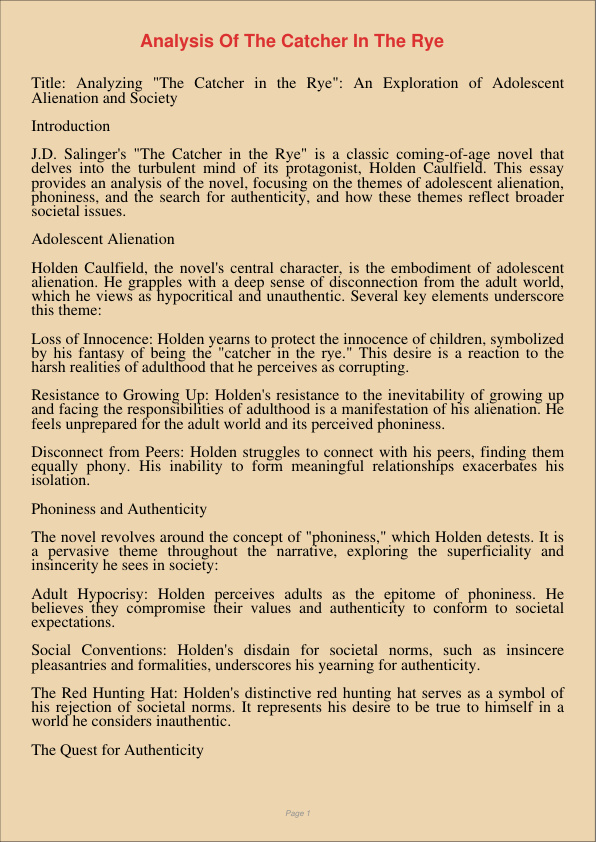Analysis Of The Catcher In The Rye
Dec 31, 2023
rye
catcher
Management
Visual Arts & Film Studies
Title: Analyzing “The Catcher in the Rye”: An Exploration of Adolescent Alienation and Society
Introduction
J.D. Salinger’s “The Catcher in the Rye” is a classic coming-of-age novel that delves into the turbulent mind of its protagonist, Holden Caulfield. This essay provides an analysis of the novel, focusing on the themes of adolescent alienation, phoniness, and the search for authenticity, and how these themes reflect broader societal issues.
Adolescent Alienation
Holden Caulfield, the novel’s central character, is the embodiment of adolescent alienation. He grapples with a deep sense of disconnection from the adult world, which he views as hypocritical and unauthentic. Several key elements underscore this theme:
Loss of Innocence: Holden yearns to protect the innocence of children, symbolized by his fantasy of being the “catcher in the rye.” This desire is a reaction to the harsh realities of adulthood that he perceives as corrupting.
Resistance to Growing Up: Holden’s resistance to the inevitability of growing up and facing the responsibilities of adulthood is a manifestation of his alienation. He feels unprepared for the adult world and its perceived phoniness.
Disconnect from Peers: Holden struggles to connect with his peers, finding them equally phony. His inability to form meaningful relationships exacerbates his isolation.
Phoniness and Authenticity
The novel revolves around the concept of “phoniness,” which Holden detests. It is a pervasive theme throughout the narrative, exploring the superficiality and insincerity he sees in society:
Adult Hypocrisy: Holden perceives adults as the epitome of phoniness. He believes they compromise their values and authenticity to conform to societal expectations.
Social Conventions: Holden’s disdain for societal norms, such as insincere pleasantries and formalities, underscores his yearning for authenticity.
The Red Hunting Hat: Holden’s distinctive red hunting hat serves as a symbol of his rejection of societal norms. It represents his desire to be true to himself in a world he considers inauthentic.
The Quest for Authenticity
Throughout the novel, Holden searches for authenticity and genuine connection in a world he views as counterfeit:
Allie and Phoebe: Holden’s love for his deceased brother, Allie, and his younger sister, Phoebe, embodies his yearning for purity and authenticity. They represent his hope for genuine human connections.
Jane Gallagher: Jane, a girl from Holden’s past, is a symbol of authenticity for him. His concern for her is rooted in his desire to preserve her genuine, unspoiled nature.
The Museum of Natural History: Holden’s fondness for the museum, where everything remains frozen in time, illustrates his longing for a world that doesn’t change, a world that retains its authenticity.
Conclusion
“The Catcher in the Rye” offers a profound exploration of adolescent alienation, phoniness, and the quest for authenticity. Holden Caulfield’s journey through a world he finds insincere and hypocritical serves as a lens through which the reader can examine broader societal issues. The novel raises questions about the authenticity of human connections, the impact of societal conventions on individuality, and the struggle to preserve innocence in the face of a seemingly inauthentic world. “The Catcher in the Rye” remains a timeless and thought-provoking work that continues to resonate with readers of all ages.
